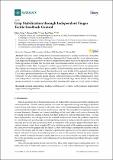Grip Stabilization through Independent Finger Tactile Feedback Control
Author(s)
Fernandes Veiga, Filipe; Edin, Benoni; Peters, Jan
Downloadsensors-20-01748.pdf (20.42Mb)
Publisher with Creative Commons License
Publisher with Creative Commons License
Creative Commons Attribution
Terms of use
Metadata
Show full item recordAbstract
Grip force control during robotic in-hand manipulation is usually modeled as a monolithic task, where complex controllers consider the placement of all fingers and the contact states between each finger and the gripped object in order to compute the necessary forces to be applied by each finger. Such approaches normally rely on object and contact models and do not generalize well to novel manipulation tasks. Here, we propose a modular grip stabilization method based on a proposition that explains how humans achieve grasp stability. In this biomimetic approach, independent tactile grip stabilization controllers ensure that slip does not occur locally at the engaged robot fingers. Local slip is predicted from the tactile signals of each fingertip sensor i.e., BioTac and BioTac SP by Syntouch. We show that stable grasps emerge without any form of central communication when such independent controllers are engaged in the control of multi-digit robotic hands. The resulting grasps are resistant to external perturbations while ensuring stable grips on a wide variety of objects.
Date issued
2020-03Department
Massachusetts Institute of Technology. Computer Science and Artificial Intelligence LaboratoryJournal
Applied Sciences
Publisher
Multidisciplinary Digital Publishing Institute
Citation
Veiga, Filipe et al. "Simulation of Skeletal Muscles in Real-Time with Parallel Computing in GPU." Sensors 20, 6 (March 2020): 1748 © 2020 The Author(s)
Version: Final published version
ISSN
2076-3417